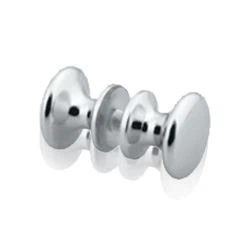Hey there! As a supplier of CNC Lathe Components, I've had my fair share of experiences with these amazing machines. One part that often doesn't get as much attention as it should is the counterweight. So, let's dive into what the functions of the counterweight in CNC lathe components are.


First off, balance is key in a CNC lathe. The counterweight plays a crucial role in achieving that balance. You see, when a CNC lathe is in operation, there are all sorts of forces at play. The cutting tools are moving, the workpiece is rotating, and there's a lot of vibration going on. Without proper balance, these forces can cause the lathe to be unstable. And an unstable lathe is a recipe for disaster. It can lead to inaccurate cuts, poor surface finishes, and even damage to the machine itself.
The counterweight helps to counteract the forces generated by the moving parts of the lathe. By adding a carefully calibrated counterweight, we can ensure that the center of gravity of the lathe remains stable. This is especially important when dealing with heavy workpieces or high - speed operations. For example, if you're cutting a large, heavy piece of metal, the force exerted on one side of the lathe can be quite significant. The counterweight on the opposite side helps to even out these forces, preventing the lathe from tipping or vibrating excessively.
Another important function of the counterweight is to reduce wear and tear on the lathe components. When a lathe is unbalanced, the extra stress on the bearings, motors, and other moving parts can cause them to wear out much faster. This means more frequent maintenance and replacement costs. But when the counterweight does its job, it distributes the forces evenly across the lathe. As a result, the components experience less stress, which extends their lifespan. This is a huge benefit for any CNC lathe operator, as it saves both time and money in the long run.
In addition to balance and wear reduction, the counterweight also contributes to the overall precision of the CNC lathe. Precision is the name of the game in the manufacturing industry. Even the slightest deviation can result in a defective product. The counterweight helps to keep the lathe steady, which in turn allows for more accurate cutting and machining. When the lathe is balanced, the cutting tools can move smoothly and precisely along the workpiece, ensuring that the final product meets the exact specifications.
Now, let's talk a bit about how the counterweight is designed and installed. The design of the counterweight depends on the specific model and application of the CNC lathe. Different lathes have different requirements based on their size, the type of work they do, and the materials they process. In some cases, the counterweight may be a simple block of metal, while in others, it could be a more complex assembly.
During the installation process, it's crucial to ensure that the counterweight is placed in the right position and that its weight is accurately calibrated. This usually involves some trial and error. The operator will start by installing the counterweight and then running some test cuts. Based on the results, adjustments can be made to the position or weight of the counterweight until the desired balance is achieved.
As a supplier of CNC Lathe Components, we understand the importance of providing high - quality counterweights. We work closely with our customers to ensure that they get the right counterweight for their specific needs. Our counterweights are made from top - grade materials, which ensures their durability and reliability.
We also offer Investment Casting Parts that can be used in conjunction with the counterweights. Investment casting is a great method for producing complex and precise parts. These parts can be customized to fit the exact requirements of your CNC lathe, further enhancing its performance.
If you're in the market for CNC lathe components, including counterweights, we'd love to hear from you. Whether you're a small - scale workshop or a large manufacturing facility, we have the products and expertise to meet your needs. Contact us to start a discussion about your requirements and let's work together to find the best solutions for your CNC lathe.
In conclusion, the counterweight in CNC lathe components is an often overlooked but essential part of the machine. It provides balance, reduces wear and tear, and improves precision. By choosing the right counterweight and ensuring its proper installation, you can significantly enhance the performance and lifespan of your CNC lathe. So, don't underestimate the power of this small but mighty component!
References
- "CNC Lathe Handbook", a comprehensive guide on CNC lathe operation and components.
- Industry research papers on the importance of balance in machining processes.



